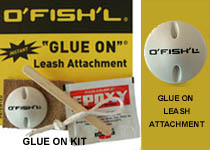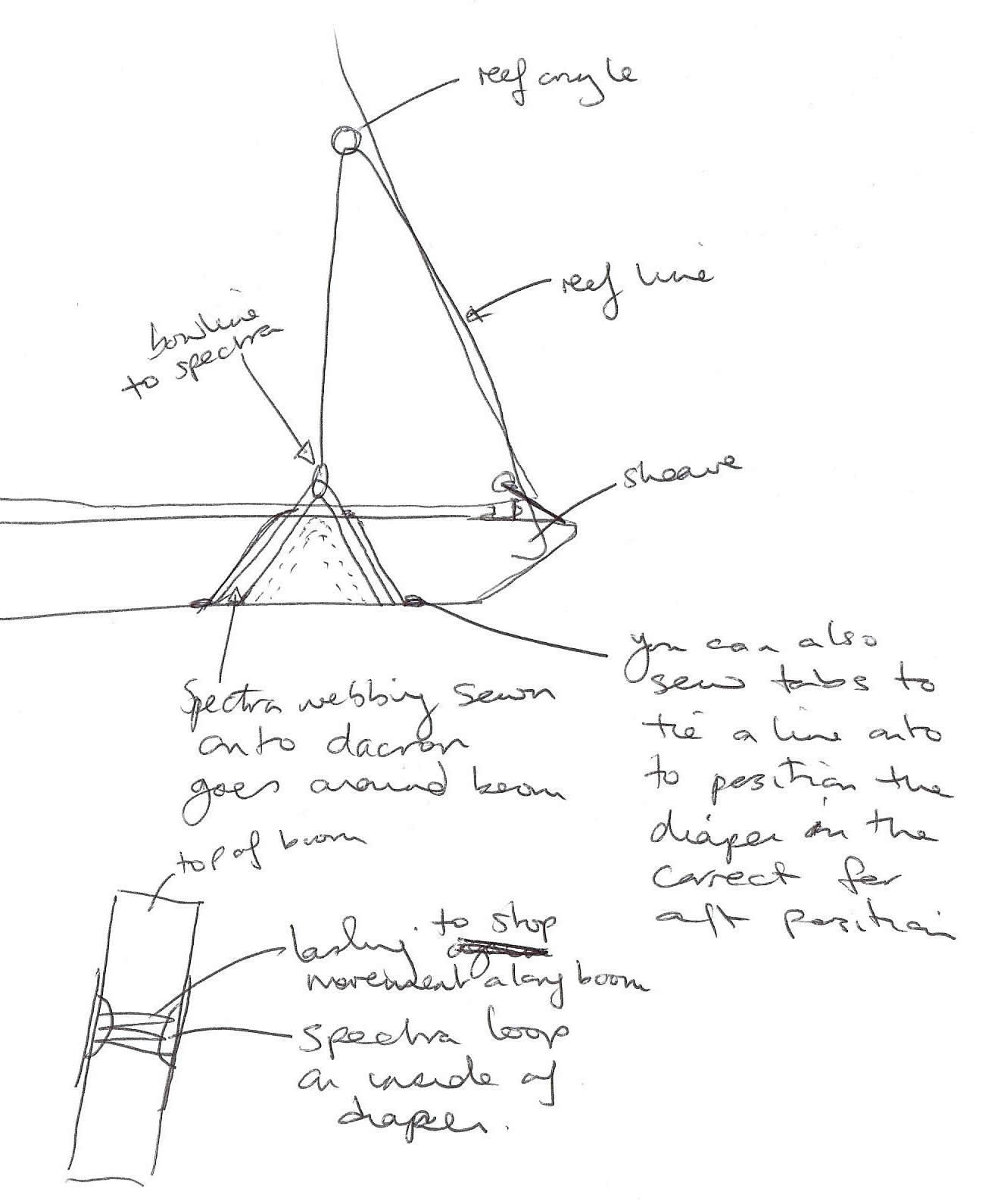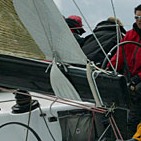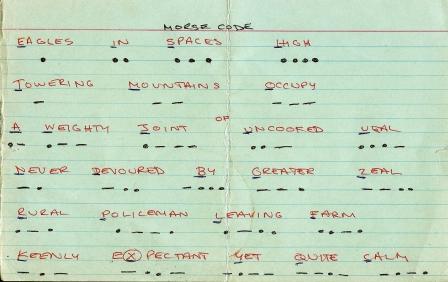Jib sheet in haulers
This inhauler is a simple sailmakers thimbel with a stainless bar tack welded to seperate the jib sheet from the inhauler. The edges are padded to stop any damage to the gel coat on the coach roof.

Tie Downs – ORC 2.03.2
2.03.2 Heavy items:
a) ballast, ballast tanks and associated equipment shall be permanently installed
b) heavy movable items including e.g. batteries, stoves, gas bottles, tanks, toolboxes and anchors and chain shall be securely fastened
c) heavy items for which fixing is not specified in Special Regulations shall be permanently installed or securely fastened, as appropriateÂ
I use padeyes from O’fishl and glue them on to the hull with 5200 you can also use thickened epoxy. A simple and quick way to comply with the rule.

Coastal Cup – a drift
After a lot of work to get the Quest 33 ready for Cat 2 racing Wayne the owner of the Quest 33 RYM is looking after lent us the boat for Coastal Cup. With a crew of 4 – Mark English (Moore 24 owner), Richard Leslie (Melges 32 owner), Olivier Lapparra and myself set off hoping all the forecasts were wrong.
You know you are in for a long race when Commanders sends you and email that starts
1) This does not look to be a lot of fun
a) can be a very fast race, but it looks really, really slow this year, especially tonight, Fri morning, and again Fri night
We didn’t have a good start – second row and very slow. There was a large ebb and we were well clear of the line for the start of Class A. So with a no wind and a rolling start sequence it took us 5 minutes to get to the line and I squeezed up between the J109 and the anchor rode of the start boat – they were kind to let us in was cheeky for us to go in there but with both of us moving at 1.5 knots it wasn’t in his interest to punch it up and push us out.
We tacked straight away so as not to sit on their wind and also because although the most ebb was on the city front it looked very slow going that way. We ended up tacking up to the bridge between Angel and Treasure cutting across to the city front around Blackhaller and then heading out very close to the south tower and working middle to left side outside the bridge. There was a very light NW at this point and we started reaching south at about 200 so that we didn’t close on the coast as per Commanders suggestion of keeping offshore.
All the other boats started to hoist their kites but weren’t even making it around Point Montara so we held off. Finally we decided it was time to hoist and just as I got the spinnaker hooked up a wind line moved towards us and everyones spinnakers backwinded. The light southerly has arrive way early it was only around 1pm. As we sat their trying to make 4 knots of boat speed a whale surfaced next to us several times – beautiful.
We beat till 5pm and dialed all the buoys to get real time conditions every one was showing southerlies less than 10 knots of wind. The crew made a decision it was time to go home – there were better things to do than drift offshore for 4 days. We hoisted the kite and to really show us how much it sucked that wouldn’t even set so it was time for the engine. We motored until we had 10 knots of wind and then hoisted the kite and sailed into a fog bank with about 200m visibility. When we sailed under the bridge you could hardly make out the underside of the roadway. We crossed in front of a container ship sailing at 10 knots missing it by about 250 meters and emerged into a beautiful sunset off coastguard point (sausalito). By the time we got back to the dock, cleaned up the boat and ate dinner it was 11pm.
It is 5pm on Saturday 55 hours after the start and two boats have finished and 5 are still racing. The Beneteau 42 is bringing up the back and is only 140 miles down the track with 137 straight line distance left to go…… I went Friday night racing last night instead with the Fennell family on Good and Plenty and had a good time doing foredeck.Back to making some bags.
Radar reflectors, sailing in fog
Several things effect how far away a vessel can be seen this is not a complete list but are the easiest to explain
1)output power of the unit a 16 mile radar is 1.5KW and a 24 mile unit is 3KW
2)heel angle at 15 degrees anything to windward is invisible and there is a significant blind spot to leeward unless the scanner is on a self leveling system
3)scanner height e.g. scanner is 5m off sea level and the target is 15 meters high the radar horizon is 13.5 miles away
4)atmospheric conditions
Radar reflectors some important points
1)mast shadowing – where ever it is mounted there is typically a 10 degree blind spot aft of the mast if it is mounted on the front. With movement of the vessel however, the return will be pretty consistent of at least 5 miles.
2)Material – some materials absorb (fiberglass absorbs 50% of the beam) others like steel and aluminum reflect even if there is some reflection it might be so erratic that it can”t be monitored on the screen.
3)Standards – 10 m2 is minimum in US reflectors must show range of 4 nm in calm sea.
4)Type –click here for the MAIB commissioned report on radar reflectors and also the MCA Guidance document
a)the octahedral if they are less than 18†wide are useless, shouldn”t be hoisted by the corner and even when it is hoisted correctly they have a blind spot of 120 degrees increasing to 180 degrees when heeled under sail you have a 50/50 chance of being seen
b)the mobri cylinders show nothing at all
c) if you have power and the money go with a Sea Me system it is the best on the market
c)RYM buys Echomax 230 I Inflatables see http://www.echomax.co.uk/Echomax_Products.htm
| ECHOMAX EM230+ | BLIPPER 210-7 | |
| RCS Peak m2 | 24m2 | April 2001 6.3m2 Nov 2001 7.96m2 |
| Response below peak | 12 peaks 20m2 @ 30 Degree intervals | Peaks – 4m2 & 5m2 |
| Performance @ 1.25m2 | 100% | 100% |
| Performance @ 2.5m2 | 100% | 54% |
| Performance @ 5m2 | 100% | 8% |
| Performance @ 10m2 | 70% | zero |
| + or – 3 Degrees heel | 24 sq.m @ 2.5m2- no nulls | 7.96 Seven nulls exceed 10 Degrees |
| + or – 9 Degrees heel | 19 sq.m peak @ 2.5m2 no nulls | 7.0 Seven nulls 28.5% (102.6 Degrees) |
| + or – 15 Degrees heel | 9 sq.m peak | 7.0 Seven nulls 45% (162 Degrees) |
| + or – 20 Degrees heel | 5 sq.m peak | Not tested |
| Overall length | 610 mm | 595 mm |
| Diameter | 248 mm | 240 mm |
| Distance between centres | EM-230 560 mm EM-220 BR (17m2) 545 mm |
545 mm |
| Weight | 2100 gr | 1879 gr |
| ISO 8729 | EXCEEDS | FAIL |
| RORC | EXCEEDS | FAIL |
| ORC | EXCEEDS | FAIL |
The above test results were obtained at QinetiQ (DERA) in April/November 2001 and May 2002.
7: Try to keep it vertical so if you are sailing and heeled over have two down lines one on each toe rail and you can use these to counter the heel to some extent.
The important things to do in fog is
1)The GPS can be more than 50 feet off so it is best to leave things at least ¼ mile off unless you have a radar
2)Keep moving don’t stop but go at a safe speed (rule 6)
3)Cross a shipping lane at the shortest point and as close to 90% as possible if you have to
4)Keep extra look out
5)Officially you should sound signals (I didn’t have it on the air horn yet but normally I tape the following onto the canister)
1.Long. Under power, making way (sound every 2 minutes)
2.Long, long. Under power, not making way (sound every 2 minutes)
3.Long, short, short. Towing, fishing, restricted ability to maneuver, sailing, and NUC (sound every 2 minutes)
4.Long, short, short, short. Manned vessel being towed (sound every 2 minutes)
5.Bell for 5 seconds At anchor (sound every minute)
6.Short, short, long. You are running into danger (also 5 shorts)
BTW: Number 6 is what I would expect to hear from that ship we were close by in the entrance to the bay if he had thought there was a problem…
6)Have the engine started
7)Listen on channel 16 and 13 in dual watch (I believe we were listening to 16 but not 13) 13 tells us vessel movements
8)Everyone with lifejackets on
9) Make Securite call on VHF if necessary
10)Alterations of course in general should be avoided after hearing a fog signal forward of the beam unless both position and movement of vessel have been determined as you could possibly present your boat into a t boning situation. See http://books.google.com/books?id=dgK3XYYhjeIC&pg=PA136&lpg=PA136&dq=altering+course+in+fog&source=web&ots=_0t80EgIUh&sig=kz90z9CZGlZP7PdOH9y2arIqbYU&hl=en&sa=X&oi=book_result&resnum=2&ct=result#PPA139,M1�
Reefing
If you think about having a reef in you should have one in. 9 out of 10 times you are faster with it in than heeling over and going sideways.
* single line reefing – good for short handed sailing but I agree it doesn’t allow great foot control.
* flattening reef (no change at the tack just takes a segment out by having a cringle on the leech)- some of the moore 24’s and express 27’s use them. Haven’t seen any on large offshore boats recently.
* slab reefing – I prefer this but I like to go with the more expensive approach of tylaska’s on a spectra strop attached to the pad eye on the side of the mast. You attach the tylaska to a ring which is sewn into the luff of the main. The advantage of this is that you don’t have to worry about the ring dropping off the horns at the mast especially if you are moving your cunningham after the reef has been put in. It is really important to have the strop at the right length so that you don’t mess with the tack set back as this can cause havoc with the groove in the rig. Last year I had a goove fail on a carbon rig when the strop was a inch too long – expensive mistake there were other things going on but that helped to exasebate (spelling!) the problem.
*reefing diapers – I use these on any booms where I am worried about the crush effect of wrapping a line around the boom. Also they mean you don’t have to worry about the placement of the reefing line along the boom. I don’t have a picture but imagine a piece of dacron in a diamond shape then sew on a piece of spectra webbing that follows the shape of the diamond with the join in the middle of the diamond and two loops extending from two opposite corners of the diamond. Then another piece of webbing on the inside which has loops that don’t extend beyond the material. You lash the diaper onto the boom using spectra laced through the loops of the shorter webbing – this allows you to put it in the correct position. You then attach the reef line to the loops that extend from the material.


*reefing cringles – I don’t believe it is ever good to tie up the extra material by going through the cringles and around the boom. The reason for this is if either your tack or clew blow you have a large chance of ripping the sail as the weight will be on the cringles. Also if it is dark and someone forgets to untie one you don’t have the same result. When you tie the bundle up if you have a loose footed main put the sail tie between the sail and the boom so if a tack or clew blows you just have a sausage foot blowing around. Also when I worked as a sailmaker they use to sew webbing with a loop in it onto a round piece of material than glue that to the sail creating a weak link whereby the loop or patch would fail before the sail would fail.
White collision flares
White flares are not distress flares they can be used for the following Â
– Â indicate your presence to a ship if there is a risk of collision.Â
– Â illumination at night in the case of a man over board but they destroy your night vision.
On my boats when going offshore I keep one flare velcroed to the handholds either side of the companionway so that if I need one quickly I just have to reach inside the companionway.
Poor mans Transpac
![]()
 Â
Â
Friday night racing was a bust only one boat finished in our class everyone else retired as there was no wind to speak of.Â
On Saturday we did the Delta Ditch Run to Stockton it was a long race as we didn’t see any wind over 15 knots and mostly it was sub 10knots. Check out some pictures below. Wayne did a great job of wing on winging with the asym down the last part of the river after a total of 72 gybes we finally finished! Every one guessed the number of gybes and the winner got to deliver the boat home! I guessed 75, Wayne 60, Delphine 100, Gus 110, Andy 99 and Rene 87.
We went aground while I was helming and managed to get off, were fouled by a J105 and well and truely got our ass kicked by the Moore 24’s and the rest of the boats in our class however we had a great time. The overnight delivery home was long 12 hour motoring and we ended up kedging off a shoal on the enterance to the harbour as we had a minus tide and even though we were in the channel there was some local knowledge we now know about!


DSC Distress Call
I found a very useful form to fill out, laminate and post in your nav station it explains how to use the DSC Distress button on your VHF. For more information on DSC and for an online simulator of using it go to http://www.boatus.com/foundation/dsc/player.html
Sailing and watching a play
On Friday I spent the day derigging a Santana 22 that my friend James just bought. The boat needs re rigging so we are bartering website work and rigging – pretty fair exchange. We cobbled together a set up that allowed us to drop the rig without a pivoting mast step – the boat is in the water and there isn’t a hoist at the marina to take the mast down the standard way. James had a clever idea to rig up a safety line from one bollard to another behind the boat so that when the rig accelerated down it would rest on that line. I would never have attempted this manouvere on a customers boat but it worked!
 Friday night we went racing Daniel didn’t come. We got stuck in the cove in no wind (for the first time in many years!) like we have seen many people do in the past and smugly we sailed around them. We were just behind Good and Plenty and tacked about 50 feet below their line as I saw the big boats coming up (we are in the same class as 40+ footers) and didn’t want to be in their lee. Well that was the end of that – two minutes into the race our fate was sealed and we sat in the confused air and no wind waiting to be put out of our misery. The crew decided drinking beers was the way to go and as I am a Perrin that doesn’t allow retiring when I am skipper we continued finishing last place a good 25 minutes behind first. However, James did get to fly the spinnaker which was good practice for him as he hasn’t done that much before and Delphine got her first sail in after coming back from India.
On Saturday Daniel and I did a doublehanded around the bay race. I helmed for the start and then decided the helm felt odd as it was loading one way than the other and the boat was sluggish so as I wasn’t enjoying it I handed it off to Daniel and crewed for the rest of the day. The kite went up and down a few times and we had a great run from Blackhaller to Southampton Shoals. We were short tacking up the city front with two other moores and were doing OK.  We passed them at Blackhaller as we had done a weather take down at Blossom so we just did a bear away set where as they had to do a gybe set. The downwind leg was a blast we were going pretty fast as their were some good gusts coming through. At one point Sunshine the other Moore was coming at us on starboard so we just gybed the main and Daniel did a great job helming with the pole on the same side as the boom until we cleared them and then gybed back inside of them aimed at Southampton. At Southampton we rounded a boat length behind Sunshine with JR the other Moore 3 boat lengths behind us. We had to let Sunshine in as they were on starboard coming into the mark and we were also worried with the antics of a cruising boat below us – we gave them a wide berth.
We lost an incredible 6 minutes to Sunshine on the beat up through Racoon Straits. I think it is down to rig tune and weight on the rail. We were giving them about 50lbs. Oh well. So Sunshine ended up 2nd corrected, JR 3rd and us 6th in class and 12th overall out of 77 boats that were entered. It was good having our own little match race going on with the other Moores and it was fun to out perform on boat handling but we are lacking in boat speed… now we need to fix that.
On Sunday I went with Gus and Delphine to the Mountain Play – The Wizard of Oz. It was a great event as usual. Maybe next year Henry will be old enough to go up there. It is fun to hike up to the amphitheatre and eat a picnic. As usual they had a fun added bonus – the dog playing Toto was cute and they had a plane fly overhead with a message from the evil witch to Dorothy.
Hope you had a great weekend.
Morse Code
I came across a neumonic for memorizing Morse Code a few years ago and forgot about it until recently when I was doing some exams and needed to know a few of the sound signals. Of course I only memorized it for the exam and promptly forgot it!


